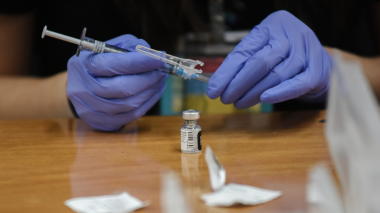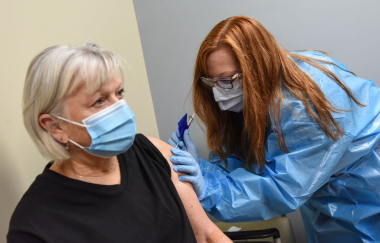The COVID-19 vaccines currently have a form of approval called Emergency Use Authorization (EUA) that allows for the manufacturing and distribution of vaccines to be streamlined in a public health emergency. More than 300 million COVID-19 vaccination doses have been given in the U.S., and the data show that the vaccines continue to be safe, effective, and our best protection against another devastating surge from newer, more contagious variants. But questions about the vaccine’s approval status are causing some to be reluctant to get the vaccine.
Christine Turley, MD, vice chair for research at Atrium Health Levine Children’s and lead physician investigator of Atrium Health’s STRIVE program, breaks down the approval process and addresses a few of the concerns some may have about the COVID-19 vaccines.
Q: There is some concern about the COVID-19 vaccine being administered under EUA. What does EUA mean?
A | EUA exists for times when there’s either a potential for a public health crisis or there is a known public health crisis. Basically, the EUA process allows for steps in the development of vaccines to happen in a highly coordinated, very efficient way. The EUA process allows the manufacturing of vaccines to begin while clinical trials are still happening. Usually, that manufacturing doesn’t begin until after the FDA has reviewed clinical trial information and the vaccine is known to work well. The FDA review of manufacturing is extensive and ongoing, and getting all this data is required for approval. The EUA process also puts the review of all the data about the vaccine or drug being considered at the top of the FDA’s “to-do” list, so that the review can get done sooner.
Sooner does not mean less safe. An analogy to consider is the normal chores you do to keep your home clean. If you do them in little chunks, spread out over each day, it might take all week to fully clean your home. But, when company is coming, you can get it done in hours. Your house isn’t less clean, you just did the same work in a shorter amount of time
For EUA, steps like review of manufacturing processes can happen at the same time as reviewing clinical trial data. And the review takes less time because it’s prioritized.
“EUA exists so that we can get life-saving vaccines and medicines to the people who need them as quickly as possible,” says Turley. “It wouldn’t be ethical if we could see early on that the vaccine was saving lives, but we decided to hold it for two years to conduct more research.”
And, after EUA is given, the FDA continues to review safety data, as was seen in the pause earlier this year of administration of the Johnson & Johnson vaccine. The FDA continues to work with the vaccine developer and clinical researchers, looking closely at data and planning next steps.
Q: How can we be sure the vaccines approved through EUA are safe?
A | The FDA conducted a rigorous review of the clinical research, analyzing the results of the approximately 117,000 Americans who participated in the vaccine studies.
This is nearly 69 times the amount of people who participate in prescription drug studies on average. The median total number of patients for an approved drug from 2015-2017 was 1,740 according to a 2020 JAMA study.
Review for yourself: Information from the FDA, including the full FDA briefing documents, advisory committee meetings and more.
The development of these vaccines was also based on a wealth of scientific work that had been done previously in the laboratory and in animals, and all the vaccine science we have learned working with people across the globe over decades of developing vaccines that have saved lives.
“It’s amazing how much science has advanced over the last 70 years,” says Turley. “If this pandemic had come 30 or 40 years ago, we wouldn’t have the scientific knowledge we have now. The tragic loss of life, negative health outcomes, and the devastating impact on society from the pandemic would have been so much worse. We have more understanding about the immune system and the ability to minimize side effects. I’m so grateful we have been able to build on this foundation.”
Q: There’s a perception that once the FDA gives full approval, the vaccine will be different than what was administered under the EUA. Is this accurate?
A | No. It’s the same vaccine. “What happens under full approval is that the FDA does an even deeper dive into the data,” says Turley. “The FDA is looking at more participants over a longer period of time to know how long the vaccine works, how well it works in different groups of people, the impact of the changing COVID-19 virus, and if a booster will be needed.”
Q: When is full FDA approval expected for the COVID-19 vaccine?
A | The FDA has given Pfizer’s COVID-19 vaccine full approval for those 16 years old and older. The Moderna and Johnson & Johnson vaccines are still under EUA, and use of the Pfizer vaccine for children 12-15 years old is still under EUA. The FDA review and approval processes are really the gold standard world-wide, and having multiple vaccines that are available through either full approval or EUA has been so impactful and important. While other countries have their own approval processes, what our FDA does carries weight for people everywhere. We are so fortunate to have that expertise as one of the greatest tools we have to fight COVID-19.
Q: Are the COVID-19 vaccines that have received EUA still experimental?
A | The “E” in “EUA” is “Emergency,” not “Experimental.” So, the people who have received the vaccines since they were given EUA are not in vaccine trials – they are not part of an experiment.
“The experimental portion happened in the trials before emergency use was authorized and vaccine distribution began,” says Turley. “The people who participated in the trials continue to be monitored and studied closely to help us learn more about how long the vaccine works and if a booster will be needed.”
EUA status will typically last throughout an emergency – and we are not yet at the end of this crisis. During the emergency, new information is reviewed continuously, and when enough is available for the full review, that occurs, like what is now underway for these vaccines. Everyone really wants the same thing: to learn as quickly as possible what will get us past the pandemic. We must all try to stay open to this learning process, even when there is pandemic fatigue or uncertainty.
Q: What do we know about the potential long-term impact of this vaccine?
A | We base our knowledge of potential long-term effects on the more than seven decades of vaccine research we have. We know that vaccines aren’t like a daily pill that can accumulate in our bodies. The vaccine is a “one (or 2) doses and done”. Our bodies are very good at getting rid of things that don’t belong there. So, when we get a vaccine, our body’s immune system gets rid of it quickly. As our body is getting rid of the vaccine parts, our immune system says, “Hey this doesn’t belong here, so we’ll get rid of it....and develops antibodies and other helper cells…And if this shows up again, we’re ready.” That’s the whole point of a vaccine.
We expect some mild side effects with vaccines specifically in the first week, sometimes two weeks. Possible fever, fatigue. These are usual when our immune system is getting rid of something and responding to it. We know that typically after four weeks that if those side effects haven’t happened, they won’t happen.
The long-term pieces that we look at are more about how long the protection will last. Of course, along the journey researchers are going to be checking for safety. That’s just good research practice. But the main focus in the long-term is how long the vaccine lasts.
“I understand the concern around a new vaccine. But I think the concern over long-term side effects is a myth that has its roots back many years ago when we had less understanding of how our immune systems work, and when vaccines were in the early stage of the science. Like many myths, it can take a long time to help people accept other information rooted in scientific data and studies,” says Turley. “People should feel confident that vaccines have been studied and the timing of when something unusual or concerning is known. There are many decades of experience with vaccines--this evidence is very strong.”
Q: If fellow employees, family, or friends told you they’re reluctant to get the vaccine, what would you say to them?
A | “I know this has been weighing on everyone’s mind for a while now. The bottom line is that with so many doses of these vaccines being given worldwide, we’re getting a good understanding of the risks—and the very clear benefits,” says Turley. “The risk of getting COVID-19 is real, and the risk of long-term complications is real. The opportunity to get the protection offered by the vaccine and reduce our own risk of severe illness is real. We have this amazing tool right in our hands, and we are allowing uncertainty to hurt our whole society. It is like being in a battle and having a new shield at our feet. We may not know if it works against every possible harm we may encounter, but would we leave it on the ground? Or would we pick it up and try our best to protect ourselves? The available vaccines are strong shields, and we are fortunate enough to have ready access to them in our country.
“We are seeing the Delta variant emerge and we’re truly concerned about overwhelming the health systems again. We’re seeing the surge in infections affect many different populations than were initially made sick, and there is clear information known that the individuals who are getting sickest and dying are almost completely unvaccinated. Each of us can take a step in helping protect both ourselves and those around us from the consequences of COVID-19.
“A year ago, we were all scrambling, filled with fear and wondering when this pandemic would end. We’re not at the end and Delta is alarming folks around the world. We have tools now to help us get there, and they are powerful. I hate to see anyone miss out on the value of decades of experience that allowed development and production of a vaccine that works so well and so safely. It makes the tragedy worse to see that some people are cheating themselves of that value. We all crave a day when the worry and conflict of the pandemic is behind us. And I hate to see anyone lose out when the stakes are so high.”
Learn more about the vaccine and where to schedule your vaccination.



